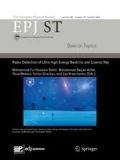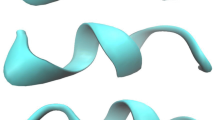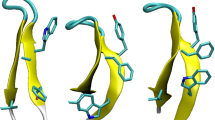Abstract
Coarse grained (CG) models are widely used in studying peptide self-assembly and nanostructure formation. One of the recurrent challenges in CG modeling is the problem of limited transferability, for example to different thermodynamic state points and system compositions. Understanding transferability is generally a prerequisite to knowing for which problems a model can be reliably used and predictive. For peptides, one crucial transferability question is whether a model reproduces the molecule's conformational response to a change in its molecular environment. This is of particular importance since CG peptide models often have to resort to auxiliary interactions that aid secondary structure formation. Such interactions take care of properties of the real system that are per se lost in the coarse graining process such as dihedral-angle correlations along the backbone or backbone hydrogen bonding. These auxiliary interactions may then easily overstabilize certain conformational propensities and therefore destroy the ability of the model to respond to stimuli and environment changes, i.e. they impede transferability. In the present paper we have investigated a short peptide with amphiphilic EALA repeats which undergoes conformational transitions between a disordered and a helical state upon a change in pH value or due to the presence of a soft apolar/polar interface. We designed a base CG peptide model that does not carry a specific (backbone) bias towards a secondary structure. This base model was combined with two typical approaches of ensuring secondary structure formation, namely a C α -C α -C α -C α pseudodihedral angle potential or a virtual site interaction that mimics hydrogen bonding. We have investigated the ability of the two resulting CG models to represent the environment-induced conformational changes in the helix-coil equilibrium of EALA. We show that with both approaches a CG peptide model can be obtained that is environment-transferable and that correctly represents the peptide's conformational response to different stimuli compared to atomistic reference simulations. The two types of auxiliary interactions lead to different kinetic behavior as well as to different structural properties for fully formed helices and folding intermediates, and we discuss the advantages and disadvantages of these approaches.
Similar content being viewed by others
References
R.O. Dror, R.M. Dirks, J.P. Grossman, H. Xu, D.E. Shaw, Annu. Rev. Biophys. 41, 429 (2012)
A. Morriss-Andrews, J.-E. Shea, Annu. Rev. Phys. Chem. 66, 643 (2015)
J.-E. Shea, C.L. Brooks III, Annu. Rev. Phys. Chem. 52, 499 (2001)
C. Wu, J.-E. Shea, Curr. Opin. Struct. Biol. 21, 209 (2011)
J.A. Lemkul, D.R. Bevan, ACS Chem. Neurosci. 3, 845 (2012)
E. Brini, E.A. Algaer, P. Ganguly, C. Li, F. Rodríguez-Ropero, N.F.A. van der Vegt, Soft Matter 9, 2108 (2013)
S. Riniker, J.R. Allison, W.F. van Gunsteren, Phys. Chem. Chem. Phys. 14, 12423 (2012)
M.G. Saunders, G.A. Voth, Curr. Opin. Struct. Biol. 22, 144 (2012)
S. Takada, Curr. Opin. Struct. Biol. 22, 130 (2012)
V. Tozzini, Quart. Rev. Biophys. 43, 333 (2010)
W.G. Noid, J. Chem. Phys. 139, 090901 (2013)
O. Engin, A. Villa, C. Peter, M. Sayar, Macromol. Theory Simul. 20, 451 (2011)
F. Rodríguez-Ropero, N.F.A. van der Vegt, Phys. Chem. Chem. Phys. 17, 8491 (2015)
F. Rodríguez-Ropero, T. Hajari, N.F.A. van der Vegt, J. Phys. Chem. B 119, 15780 (2015)
C. Dalgicdir, C. Globisch, C. Peter, M. Sayar, PLoS Comput. Biol. 11, e1004328 (2015)
S. Prajapati, V. Bhakuni, K.R. Babu, S.K. Jain, Europ. J. Biochem. 255, 178 (1998)
M. Golczak, The FASEB J. (2001)
H.J. Dyson, P.E. Wright, Curr. Opin. Struct. Biol. 12, 54 (2002)
D.E. Draper, D. Grilley, A.M. Soto, Annu. Rev. Biophys. Biomol. Struct. 34, 221 (2005)
V. Receveur-Bréchot, J.-M. Bourhis, V.N. Uversky, B. Canard, S. Longhi, Proteins: Struct. Funct. Bioinf. 62, 24 (2005)
C. Dalgicdir, M. Sayar, J. Phys. Chem. B 119, 15164 (2015)
O. Engin. M. Sayar, J. Phys. Chem. B 116, 2198 (2012)
C. Dalgicdir, O. Sensoy, C. Peter, M. Sayar, J. Chem. Phys. 139, 234115 (2013)
I. Dikiy, D. Eliezer, Biochim. Biophys. Acta – Biomembr. 1818, 1013 (2012)
H.A. Lashuel, C.R. Overk, A. Oueslati, E. Masliah, Nat. Rev. Neurosci. 14, 38 (2012)
L. Jean, C.F. Lee, C. Lee, M. Shaw, D.J. Vaux, The FASEB J. 24, 309 (2009)
L. Jean, C.F. Lee, D.J. Vaux, Biophys. J. 102, 1154 (2012)
A. De Simone, C. Kitchen, A.H. Kwan, M. Sunde, C.M. Dobson, D. Frenkel, Proc. Natl. Acad. Sci. USA 109, 6951 (2012)
W. Li. Gala, Adv. Drug Delivery Rev. 56, 967 (2004)
V. Tozzini, W. Rocchia, J.A. McCammon, J. Chem. Theory Comput. 2, 667 (2006)
O. Bezkorovaynaya, A. Lukyanov, K. Kremer, C. Peter, J. Comput. Chem. 33, 937 (2012)
A.V. Smith, C.K. Hall, Proteins 44, 344 2001
T. Bereau, M. Deserno, J. Chem. Phys. 130, 235106 (2009)
S. Pronk, S. Páll, R. Schulz, P. Larsson, P. Bjelkmar, R. Apostolov, M.R. Shirts, J.C. Smith, P.M. Kasson, D. van der Spoel, et al., Bioinformatics, btt055 (2013)
W.F. Van Gunsteren, H.J.C. Berendsen, Mol. Simul. 1, 173 (1988)
M. Bonomi, D. Branduardi, G. Bussi, C. Camilloni, D. Provasi, P. Raiteri, D. Donadio, F. Marinelli, F. Pietrucci, R.A. Broglia, M. Parrinello, Comput. Phys. Commun. 180, 1961 (2009)
G. Bussi, Mol. Phys. 112, 379 (2014)
V. Rühle, C. Junghans, A. Lukyanov, K. Kremer, D. Andrienko, J. Chem. Theory Comput. 5, 3211 (2009)
W. Humphrey, A. Dalke, K. Schulten, J. Mol. Graph. 14, 33 (1996)
D. Frishman, P. Argos, Proteins: Struct. Funct. Bioinf. 23, 566 (1995)
W. Tschöp, K. Kremer, J. Batoulis, T. Bürger, O. Hahn, Acta Polym. 49, 61 (1998)
V.A. Harmandaris, N.P. Adhikari, N.F.A. van der Vegt, K. Kremer, Macromolecules 39, 6708 (2006)
Th. Soddemann, B. Dünweg, K. Kremer, Eur. Phys. J. E 6, 409 (2001)
J.D. Weeks, D. Chandler, H.C. Andersen, J. Chem. Phys. 54, 5237 (1971)
F. Ramezanghorbani, A transferable coarse-grained model for peptides that display an environment driven conformational transition. Master's thesis, Koc University, Koc Universitesi Sariyer Istanbul Turkey, 7 (2015)
B. Hess, D. van Der Spoel, E. Lindahl, Gromacs user manual version 4.5.7. (University of Groningen, Netherland, 2010)
W. Kabsch, C. Sander, Biopolymers 22, 2577 (1983)
Author information
Authors and Affiliations
Corresponding authors
Electronic supplementary material
Supplementary file supplied by authors.
Rights and permissions
About this article
Cite this article
Dalgicdir, C., Globisch, C., Sayar, M. et al. Representing environment-induced helix-coil transitions in a coarse grained peptide model. Eur. Phys. J. Spec. Top. 225, 1463–1481 (2016). https://doi.org/10.1140/epjst/e2016-60147-8
Received:
Revised:
Published:
Issue Date:
DOI: https://doi.org/10.1140/epjst/e2016-60147-8




